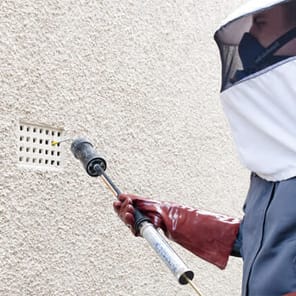The queen wasp will venture from her winter hibernation location in search of a suitable nesting site in late April/May. Wasps Nests are frequently found in garden hedges, under eaves, in sheds or outbuildings, or in wall cavities and lofts.
Completed nests can hold up to 10,000 wasps and measure more than 30cm in diameter. Most problems are encountered with wasps in August and September when workers have finished the nest building and crave sweet sources of food. It is often that wasp nests are identified at this time of year.
Where nests are still small it is possible to treat the nest using the DIY sprays available from London Pest Control.
During the summer months however the nest rapidly grow and can contain many thousands of wasps all of which can deliver a painful sting. Removal of these nests should not be treated lightly – the wasps become more aggressive towards late summer and can swarm around the nest making treatment in enclosed areas such as loft spaces particularly dangerous.
We use professional insecticidal contact powder or direct permethrin spray to destroy the nest.
If you are suffering with a moth infestation in London, our team of specialists can fumigate your house or workplace to remove the moths and leave your property pest-free. Not only can moth infestations be very frustrating, but the moths can also cause severe damage to fabrics and other things within your home or workplace.
It’s necessary that you get Moth and Wasp Pest Control experts in to complete the moth infestation who understand how to execute the task to a high standard. By having a business which is not correctly qualified; you’ll find some pests are overlooked, which may bring about complications later on. When making use of our specialists, you can help have a pest-free house as soon as possible as we have got plenty of experience and specialist knowledge.
There are lots of companies who claim to have a great deal of knowledge inside this field; however this might not always be the case which means you must always confirm the reliability with case studies. Please do not hesitate to speak to us regarding moth control.
We Have Extensive Experience in Eradicating Pests
Moths are one of the most common household pests in the UK. As with other pests like carpet beetles and biscuit beetles, it is the moth larvae which is responsible for the familiar fabric damage you might see on your carpets, clothes, bed linen and more.
Clothes moth larvae can leave a trail of damage, chewing through fabrics easily, and the fibres of these fabrics are used as to build their cocoon. The larvae gain their nourishment from fabrics, and are known to have a large appetite, and you may not spot an infestation until you see fully grown adult moths in your home.

Getting rid of moths from your property will naturally put a stop to the presence of larvae, but this can be difficult without the aid of a professional. Our Moth and wasp control experts offer a reliable, prompt and discreet moth control service to households throughout London and the surrounding areas.
Our fully trained technicians can identify and eradicate moth infestation, as well as providing advice on how to prevent another moth infestation in the future.
For a quotation, free survey or if you simply need some advice, please contact Cityspec on 020 8687 4206. Or complete our online form for a Instant Response to your enquiry.
How Do we Work?
Different damage to fabrics and materials
- Common clothes moth larvae cause irregular shaped holes in fabrics;
- Case bearing clothes moth larvae create smaller, more regular shaped holes in garments;
- Brown house moth larvae tend to prefer animal based materials like feathers and leather;
- White shouldered house moth larvae scavenge on a wide range of food, so are a little less damaging to textiles.


Why are moths a pest?
What kills moth larvae?
What are moths attracted to?
Can moths live in mattresses?
We work closely with businesses across all industries.
Cityspec have always proven to be very reliable and give great practical advice whenever needed. They are one of our trusted suppliers and we are very happy with the service they provide.


